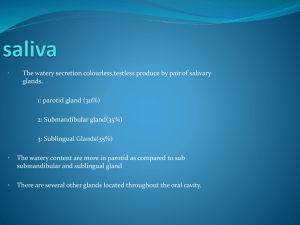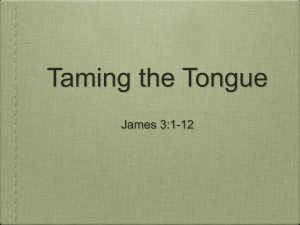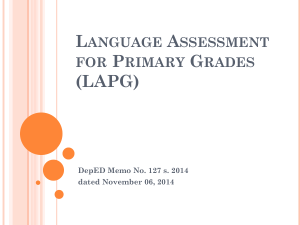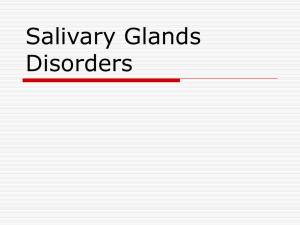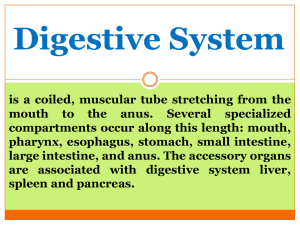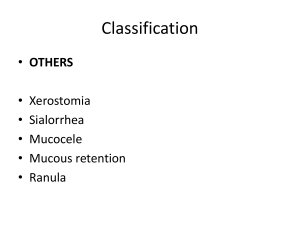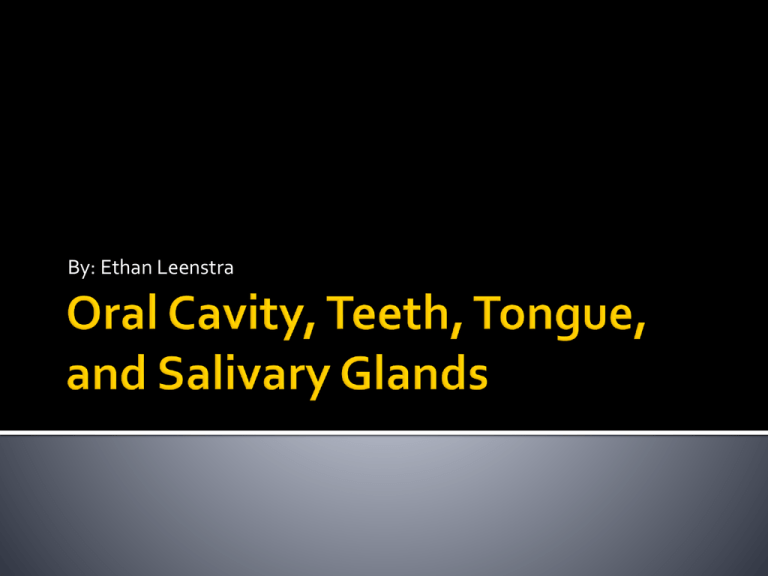
By: Ethan Leenstra
The oral cavity (or mouth)
consists of the teeth,
tongue, salivary glands,
cheeks, lips, palate (roof of
the mouth), and the floor of
the mouth
It also has a mucous lining
membrane that protects
the inside of the oral cavity
This set of organs are all a
part of the digestive system
and respiratory system
Teeth do most of the physical
breakdown in the digestive system
by crushing and tearing food to be
broken into smaller pieces
This process helps with the
saturating of materials with
salivary secretions and enzymes
and it breaks connective tissue of
meat and the plant fibres of
vegetation
There are four types of teeth:
incisors, canines, premolars, and
molars
The non-exposed part of the tooth
is the root and the exposed is the
crown (which is covered by enamelthe hardest substance of the body)
Most of the tooth is made from a
mineralized matrix almost like bone
called dentin
Another type of bony substance is
the cementum which covers the
root
There is a chamber on the inside of
the tooth called the pulp cavity and
it holds nerves and blood vessels
that come through the root canal.
Root canal is a small tunnel at the
bottom of the tooth
Each root sits in a bony socket to
hold it in place called the alveolus
Some issues with the teeth are:
Gingivitis and Periodontal disease
Gingivitis-a disease that the cells
in the gingivae (gums) break
down and can lead to infections
from bacteria
Periodontal disease-when the
gums recede from the teeth to
create erosion by bacteria going
into the gums. This causes tooth
loss
The tongue helps in chewing,
creates bolus, and prepares it for
swallowing
Some other important things that
the tongues does are:
secrete mucous and an enzyme
lingual lipase
the mechanical processing of
food through compression,
abrasion, and distortion
And uses sensory analysis by taste
receptors, touch, and temp.
The tongue is divided into 2 parts:
the anterior body and the
posterior root
The tongue also has two types of
skeletal muscles: the intrinsic and
extrinsic tongue muscles
On the surface of the oral part of
the tongue, it contains lingual
papillae ( which are hair like
structures that give the tongue
its rough texture)
There are 4 types of papillae:
circumvallate, fungiform,
filiform, and foliate papillae
All except the filiform papillae,
have taste buds on them and
they can detect sour, sweet,
bitter, and salty
Along the lower midline of the
tongue, there is a fold of mucous
membrane called lingual
frenulum, which connects the
tongue to the floor of the oral
cavity.
Each of the papillae are
covered in a thicker
epithelium(a basic type of
animal tissue), which helps
in moving materials with
the tongue
A condition that makes the
lingual frenulum is too
hard to allow the tongue
to move and restricts
speech and eating is called
ankyloglossia
The salivary glands mainly
make the mouth moist
and also start the
digestion of complex
carbohydrates before
swallowing
They also moist and
lubricate food that is in the
mouth and they also
provide info about the
material in the mouth.
They can also dissolve
chemicals that can
stimulate the taste buds
There are 3 types of salivary
glands: Parotid salivary
gland, Sublingual salivary
glands, and the
Submandibular salivary
gland. Each gland has a
different and irregular shape
These glands are surrounded
by connective tissue and are
internally separated by lobes
A condition that affects the
salivary glands is the mumps
virus. It is a swollen parotid
gland
This gland secretes
the amylase that
breaks down carbs
These secretions are
drained through the
parotid duct and
empties into a
vestibule at the upper
second molar
25% of saliva comes
from this gland
It is on the floor of the oral
cavity and it is covered in
mucous membrane that
lies on the gland
This gland creates a
watery secretion that acts
as a buffer and lubricant
The sublingual ducts open
underneath lingual
frenulum
5% of saliva is produced in
this gland
This gland is found on the
floor of the mouth in the
mandibular groove, a dip in
the inner area of the mandible
It creates a mixture of buffers,
amylase, and glycoproteins
called mucins
Submandibular ducts are
opened right after the teeth,
on either side of the lingual
frenulum
This gland releases 70% of the
saliva created in the body
The main function of the oral cavity is to begin
digestion of food and materials. Also, a main part
in breathing and swallowing.
It provides space for food and material to come in
The mouth chews it, and mixes it with saliva
(which creates bolus). It then follows with the
swallowing process by using peristales (which
forces the food down the esophagus)
The lining in the mouth also creates lubrication ,
along with the salivary glands, make it easier to
swallow, in speech, and digestion of materials and
food
This is a condition that
restricts the movement and
range of the tongue
With this disease, the lingual
frenulum (piece of skin under
tongue) restricts the
movement of the tongue
which can cause difficulty
sticking their tongue out
Also can cause people to have
trouble eating, swallowing,
and breathing
Sometimes it can loosen on its
own, but other times, it has to
be surgically cut to remove
issues of the patient
This affects the ability to
function restricts the tongue’s
ability to help swallow, eat,
and breathe
The only treatment for this condition is that
the must cut it to ensure that the tongue is
now free from any restriction
Other doctors say that the patients should
just wait and see what will happen
This is a disease that can affect
many parts of the body, mainly
the parotid salivary gland and it
usually spreads through the
saliva
This gland is located beneath the
ear and above the jaw. And with
this condition, it usually swells
and causes pain
This affects the function of the
glands because the glands swell
and cause the gland not to
produce saliva
http://www.ghorayeb.com/TongueTie.html
www.mayoclinic.com
www.cdc.gov
www.moldbacteriaconsulting.com
http://mackesanatomy.wikispaces.com/Oral+Cavity
http://www.cancer.ca/en/cancer-information/cancertype/oral/anatomy-and-physiology/?region=on
http://www.nature.com/gimo/contents/pt1/full/gimo2.
html
http://www.mayoclinic.com/health/tonguetie/DS01200
http://kidshealth.org/parent/infections/bacterial_viral/
mumps.html#



